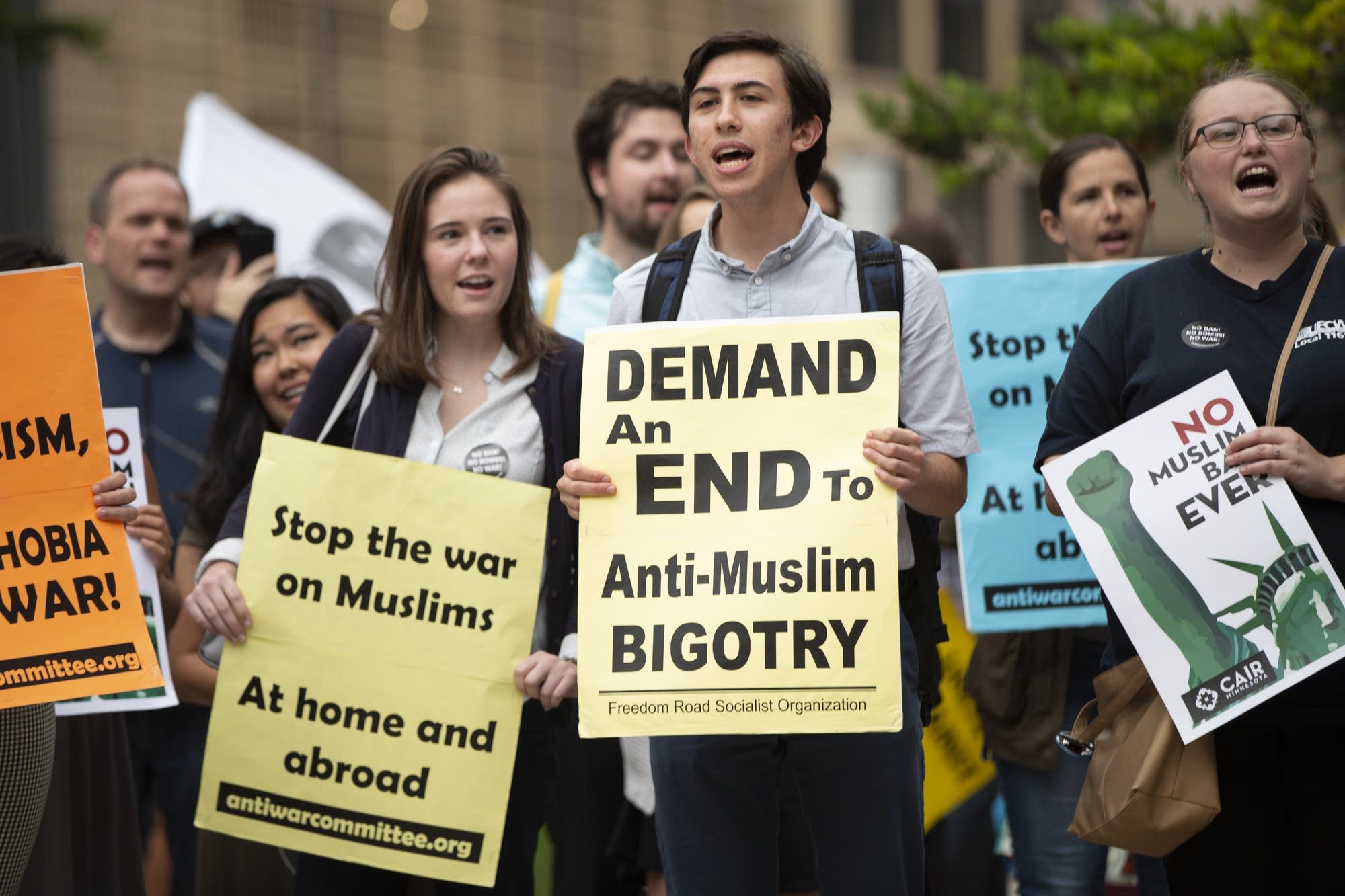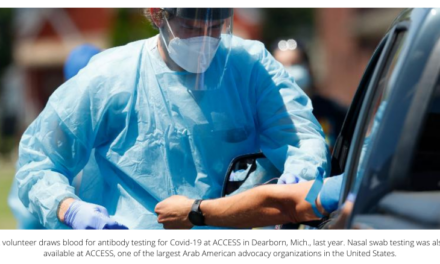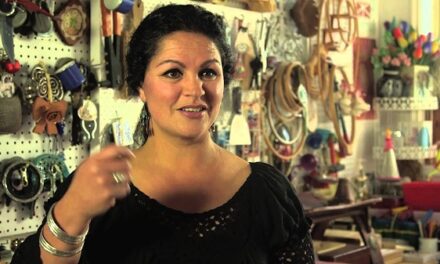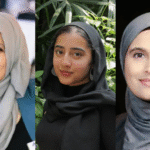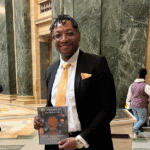It’s been six years since former president Donald Trump signed an executive order banning immigration from Muslim-majority countries. It’s been two years since President Biden rolled back the ban.
But many Minnesota refugee families are still waiting to be reunited. Sahan Journal reporter Hibah Ansari joined MPR News host Emily Bright to give a sense of the scale of the family reunification backlog.
Audio transcript
EMILY BRIGHT: It’s 12:12. I’m Emily Bright with Minnesota Now. You might remember this moment from the campaign trail during the 2016 election.
DONALD TRUMP: Donald J. Trump is calling for a total and complete shutdown of Muslims entering the United States until our country’s representatives can figure out what the hell is going on.
[CHEERS AND APPLAUSE]
We have no choice. We have no choice.
EMILY BRIGHT: It’s been six years since former President Donald Trump signed an Executive Order banning immigration from Muslim-majority countries, and it’s been two years since President Biden rolled back the ban. But many Minnesota refugee families are still waiting to be reunited. For more, Hibah Ansari is on the line. She’s a reporter with Sahan Journal. Thank you for being here.
HIBAH ANSARI: Yeah, thanks for having me.
EMILY BRIGHT: Well, it sounds like there’s a significant backlog of family reunification cases. Can you give us a sense of the scale of this problem?
HIBAH ANSARI: Sure. So as of March, there are about 20,000 refugee family reunification petitions that are at the initial stage of the application process. And then there’s another 25,000 cases that are towards the end of the application process, which is when your relatives abroad are interviewed and go through medical screenings and things like that. Most cases are actually kind of stuck at this last stage.
And since 2017, which is when the refugee ban had first started, the median processing time for these cases has since tripled to a little over two years. Now of course, that’s a median. So there are definitely cases that are taking longer than that as well.
And then locally in Minnesota, you might see some cases dating as far back as 2011 for families trying to sponsor their relatives to join them here in Minnesota.
EMILY BRIGHT: Oh my gosh. Yeah, people who have not been involved with this process don’t realize how long it takes. And I imagine that some people might imagine that when Biden rolled back the ban, the flow of refugee resettlement and family reunification would just pick right up, but that’s not the case, right?
HIBAH ANSARI: Right. There are a few things that I describe as snowballing into what the refugee resettlement system is now experiencing, but when it comes specifically to this ban, yes, Biden did roll back the refugee ban, but at that time, there was a small change in the security and vetting requirements of family reunification cases that are causing really big complications for people.
So if you’re a refugee applying to sponsor your family, your relatives have to report 10 years’ worth of phone numbers and previous addresses. Prior–
EMILY BRIGHT: That’s hard.
HIBAH ANSARI: Yeah. Prior to that, you only had to provide five years of information. But that requirement still exists. That question still exists on the form. So tracking down that information, as you can imagine, could be difficult for anyone, but particularly for refugees who experience more precarious housing situations.
So gathering that information, of course, takes a lot of time, but then running all of that information also makes a refugee more vulnerable to getting flagged for potential security threats, which has a low threshold to begin with, advocates say.
So because of that, a lot of applicants are experiencing denials, or, at the very least, delays. And we can get into some of the other things that are causing the backlog as well, but specifically when it comes to the lasting effects of the Muslim ban, this is a very clear place that we are still seeing a lot of delays.
EMILY BRIGHT: OK. What stories have you heard from families who are waiting to be reunited with each other?
HIBAH ANSARI: So in Minnesota, advocates tell me that a lot of people have really just given up hope on being able to sponsor their relatives. There are cases that haven’t seen any movement in like six years. So that’s a lot of time to be separated from your spouse, your parents, your children– young children especially you’re missing out on years of their childhood.
And at some point, people really have just given up on the waiting game. And I’d love to talk a little bit about a man I wrote about in St. Cloud, Rabi Mohamed, who’s been waiting seven years to see his family. He has been for years trying to get his case past that initial process. His petition was denied for something he later learned was not actually a requirement.
So he then sued the United States Citizenship and Immigration Services for denying his petition. And a few weeks later, his petition was granted. So his advocates say that it’s likely because his case was getting a lot of attention because of this lawsuit, but, of course, that’s just one case in a pool of thousands.
EMILY BRIGHT: What’s– oh, go ahead.
HIBAH ANSARI: Oh. I was going to say that his wife and three kids, who are currently living in a refugee camp in Ethiopia, are now going to go through that overseas processing point, which is what I mentioned before where a lot of these cases are stuck. So best case scenario, his attorney told me it could take six months for his family to join him here, but of course, that’s a best case scenario and they said that it’s much likely going to be a lot more time than that.
EMILY BRIGHT: Yeah, that’s such a long wait. What, if anything, is a US Citizen and Immigration Services doing about this?
HIBAH ANSARI: So the department reported goals in March of 2022 saying that they do want to speed up the process. So they recognize that this is a problem. For one form of family reunification cases, they want to cut the processing time to six months by the end of this September.
Right now, I’m seeing that the median processing time is about a year. But they’re aiming to expand their staff capacity and improve some of the technology of case processing so that they can eventually meet that goal. But of course, this is a tough backlog, and so it’s going to take some time to make a dent.
EMILY BRIGHT: Yeah. And of course, each number in this story is an extended family in these lives. is anyone– who’s thinking creatively about solutions? Resettlement agencies? Anyone?
HIBAH ANSARI: Yeah. So the role of resettlement agencies and the capacity that they’re able to right now is to support refugees as soon as they come to the US.
EMILY BRIGHT: Right.
HIBAH ANSARI: So they’re thinking about a person’s housing situation, their work authorization, getting kids into school. A part of that support does include helping refugees here sponsor their relatives back home, but it is just a really small part because resettlement agencies already have limited resources, and they’re prioritizing– rightfully so– the immediate needs of refugees who are already here.
But there are large organizations that are challenging the process, such as the International Refugee Assistance Project, who’s representing Rabi and his case against USCIS. And a coalition of groups that have, since 2017, been filing lawsuits challenging what they call an extreme vetting process.
So that advocacy is there and it’s happening more at the national level, but with the help and the stories of people like Rabi who live in St. Cloud.
EMILY BRIGHT: Hibah, I’m so glad you’re talking about this. What drew you to this story?
HIBAH ANSARI: Yeah. I think what sparked my interest in this story is that we often think about all these changes we saw under Trump and then all the changes that followed under Biden. But what’s happening to people like Rabi here really does transcend presidential administrations.
And people’s lives are on the line, and their families remain separated for a very long time because of this snowball of so many different challenges. And I’ve been reporting a lot about just the capacity of the refugee resettlement system right now when it comes to embassy closures across the world due to COVID or world conflicts. And the limited support or limited capacity of resettlement agencies and limited support to international groups, these all snowball and create a burden on the system. And like you said, the people who languish under this are individuals and their family members.
So yeah, it’s something I’ve been writing about for a long time, but it was very interesting to see just how this question on a form can really impact people and impact them for years as well.
EMILY BRIGHT: In the few seconds that remain, what will you be looking for in the coming weeks or months?
HIBAH ANSARI: Sure. So we’ll see if USCIS reaches its goal by the end of September to cut its processing time, but like I said, it’s a tough backlog, so making a dent will likely take some time. That’s also around the time that the Biden administration reports their maximum number of refugees that the country can support for the following year.
So that’s a number based purely on capacity, and it does reveal a lot about where we’re at and if there have been some improvement in the refugee resettlement world. So those are some things that I’ll be looking out for.
EMILY BRIGHT: Well Hibah, thank you for your time and for your reporting.
HIBAH ANSARI: Yeah, thank you so much for having me.
EMILY BRIGHT: Hibah Ansari is a reporter with Sahan Journal. That’s an independent nonprofit digital news site dedicated to reporting for immigrants and communities of color in Minnesota. You can read more of her reporting at sahanjournal.com.
